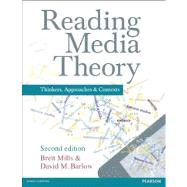- ISBN: 9781408285251 | 1408285258
- Cover: Paperback
- Copyright: 6/4/2012
Brett Mills is Head of the School of Film and Television Studies at the University of East Anglia. He is the author of Television Sitcom (British Film Institute, 2005) and The Sitcom (Edinburgh University Press, 2009).
David Barlow was Lecturer in Media, Culture and Communication in the Cardiff School of Creative and Cultural Industries at the University of Glamorgan and Director of the Centre for the Study of Media and Culture in Small Nations. He is a joint author (with Philip Mitchell and Tom O’Malley) of The Media in Wales: Voices of a Small Nation (UWP, 2005) and co-editor (with Vian Bakir) of Communication in the Age of Suspicion: Trust and the Media (Palgrave Macmillan, 2007).
1 Introduction
Part I Reading theory
2 What is theory?
3 What is reading?
Part II Key thinkers and schools of thought
4 Liberal press theory
Reading: Mill, J.S. (1997 [1859]) ‘Of the liberty of thought and discussion’, in Bromley, M. and O’Malley, T. (eds) A Journalism Reader, London: Routledge, pp. 22-6.
5 F.R. Leavis
Reading: Leavis, F.R. (1930) Mass Civilisation and Minority Culture, Cambridge: Minority Press.
6 The Frankfurt school
Reading: Horkheimer, M. and Adorno, T.W. (2002 [1944]) Dialectic of Enlightenment: Philosophical fragments, translated by Jephcott, E. Stanford, California: Stanford University Press. Excerpt from Chapter 4, ‘The culture industry: enlightenment as mass deception’, pp. 94–8.
7 Harold D. Lasswell
Reading: Lasswell, H.D. (1948) ‘The structure and function of communication in society’, in Bryson, L. (ed.) The Communication of Ideas, New York: Harper and Brothers, pp. 37-51.
8 The Columbia school
Reading: Lazarsfeld, P.F. and Merton, R.K. (1948) ‘Mass communication, popular taste and organized social action’, in Bryson, L (ed.) The Communication of Ideas, New York: Harper and Brothers, pp. 95–118.
9 C. Wright Mills: Mass society theory
Reading: Mills, C.W. (1956) ‘The mass society’, in Mills, C.W. (ed.) The Power Elite, London: Oxford University Press, pp. 298-324.
10 The Toronto school
Reading: Innis, H.A. (1951a) ‘The bias of communication’, in The Bias of Communication, Toronto: University of Toronto Press, pp. 33–60.
11 The Centre for Contemporary Cultural Studies
Reading: Hall, S. (1980c) ‘Encoding/Decoding’, in Culture, Media, Language: Working papers in cultural studies, 1972–9, Hall, S., Hobson, D., Lowe, A. and Willis, P. (eds), London: Hutchinson, pp. 128–38.
Part III Approaches to media theory
12 Political economy
Reading: Herman, E.S. (1995) ‘Media in the US political economy’, in Downing, J., Mohammadi, A. and Sreberny-Mohammadi, A. (eds) Questioning the Media: A critical introduction, 2nd edition, London: Sage, pp. 77-93.
13 Public sphere
Reading: Habermas, J. (1974 [1964]) ‘The public sphere: an encyclopedia article’, New German Critique 3 (1): 49–55.
14 Media effects
Reading: Gauntlett, D. (2005) ‘Ten things wrong with the media ‘effects’ model’, Theory.org.uk: the Media Theory Site, www.theory.org.uk/tenthings.html.
15 Structuralism
Reading: Todorov, T. (1990 [1978]) Genres in Discourse, translated by Porter, C., Cambridge: Cambridge University Press, pp. 27–38.
16 Feminist media theory
Reading: van Zoonen, L. (1994) Feminist Media Studies, London: Sage, pp. 11–18, 21–8.
17 Cultural theory
Reading: Williams, R. (1961) The Long Revolution, Orchard Park: Broadview Press, pp. 57–70.
18 New Media
Reading: Jenkins, H. (2006) Convergence Culture: Where old and new media collide, New York and London: New York University Press, pp. 2-10.
19 Postmodernism
Reading: Baudrillard, J. (1994 [1981]) ‘The implosion of meaning in the media’, in Simulacra and Simulation, translated by Glaser, S.F., Ann Arbor: University of Michigan Press, pp. 79–86.
20 The information society
Reading: Webster, F. (2002) Theories of the Information Society, 2nd edition, London: Routledge, pp. 8–21.
Part IV Media theory in context
21 Production
Reading: Hesmondhalgh, D. (2007) The Cultural Industries, 2nd edition, London: Sage, pp. 3–8.
22 Texts
Reading: Barthes, R. (1977 [1967]) ‘The death of the author’, in Image Music Text, translated by Heath, S., London: Fontana, pp. 142–8.
23 Audiences
Reading: Ang, I. (1991) ‘Audience-as-market and audience-as-public’, in Desperately Seeking the Audience, London: Routledge, pp. 26–32.
24 Audiences as producers
Reading: Shirky, C. (2008) Here Comes Everybody: How change happens when people come together, London: Penguin, pp. 55-66.
The New copy of this book will include any supplemental materials advertised. Please check the title of the book to determine if it should include any access cards, study guides, lab manuals, CDs, etc.
The Used, Rental and eBook copies of this book are not guaranteed to include any supplemental materials. Typically, only the book itself is included. This is true even if the title states it includes any access cards, study guides, lab manuals, CDs, etc.
Digital License
You are licensing a digital product for a set duration. Durations are set forth in the product description, with "Lifetime" typically meaning five (5) years of online access and permanent download to a supported device. All licenses are non-transferable.
More details can be found here.






